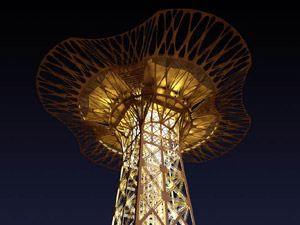Reports that the operators of Paris’s Eiffel Tower were planning a dramatic, temporary addition to the structure proved to be tall tales. The UK’s Guardian newspaper, Architect magazine, The New York Times, and others wrote in March that a design by the French firm Serero Architects had won a competition to redesign the 905-foot-tall structure’s uppermost public viewing platform in time for its 120th anniversary in 2009. Serero unveiled renderings of a clover-shaped cantilevered platform that could be “bolted onto the tower using a web of Kevlar” temporarily, the Guardian wrote. But according to an April 15 New York Times blog, the news originated with an e-mail sent by Serero’s office—not the tower’s managers—that was picked up, unchallenged, by several blogs and media outlets, giving it an air of credibility that invited still other journalists to cover the story. Its seeming veracity was boosted by David Serero’s comments to Architect, which seemed to suggest that the platform was all but a sure thing: “(The design was) selected with the condition to verify its technical feasibility. Within the next two months, we will be able to get a definite answer,” he told the magazine. Serero now says that his efforts to negotiate with the Eiffel Tower’s management were misunderstood and that his use of the word “selected” was “unintentionally” misleading. But as the Times wrote, some are speculating that the entire incident is a publicity stunt.
![]()
Listen to a podcast of these headlines and more.
Click the play button to begin | Click here to download

Officials remain “committed” to building the signature element of Santiago Calatrava’s transportation hub at the World Trade Center, but the rest of the project will be scaled back, The New York Times reported on April 16th. First unveiled in 2004, the main above-ground element of Calatrava’s design is an oblong, glass-clad hall formed by a series of steel arches; the architect has likened its shape to that of a bird taking flight. Below ground, the hub links New York City’s subway system, a commuter rail line to New Jersey, and ferry terminals—but due to concerns about rising construction costs, this area will be modified. In order to remain within a $2.5 billion budget, the Times wrote, the Port Authority of New York and New Jersey is “preparing a more modest plan that would make greater use of the existing tracks and structure of the interim PATH terminal, pare down the design of below-ground elements, increase the use of columns in wide spans and simplify some engineering.” But the agency’s director, Anthony Shorris, added that it views Calatrava’s soaring hall as “an important part of the downtown Manhattan landscape.” The hub has already been redesigned twice: once, in 2005, to strengthen its blast resistance, and again last year to value-engineer its cost down from $3.4 billion. Shorris added that “in four to six weeks, the Port Authority was likely to issue bid solicitations ‘to see what the market tells us about the pricing,’ based on the current design by Santiago Calatrava, working with the firms STV and DMJM Harris.”
Another Richard Neutra masterwork is facing an uncertain fate: the Neutra VDL Research House II, in the Los Angeles neighborhood of Silver Lake. The Cal Poly Pomona Foundation, which owns the property and operates it as a museum, could be forced to sell if it is unable to raise $2 million by the end of 2009, the Los Angeles Times reported on April 17. “Already in need of costly repairs, the house where Richard Neutra lived and worked was damaged further by winter storms that overwhelmed its flat roof, poured rain into the walls and flooded the floors. Then a steady $10,000-a-year revenue stream used to pay for basic expenses dried up.” The most pressing deadline comes this October, by which time the foundation must raise $30,000 “for insurance, utilities and upkeep of the site through 2009.” Describing the importance of the 1960s-vintage residence, the paper noted that it “addressed the question of density in Los Angeles. Neutra wanted to show that a reasonably sized house—2,100 square feet—could fit on a 60-by-70-foot lot, open to views and not hemmed in by neighbors. The design proved that a smartly planned small space could create a sense of well-being.” Cal Poly has operated the property since Neutra’s widow donated it in 1990, but a $100,000 endowment she created has since proven insufficient for covering even routine maintenance and operating expenses. Cal Poly’s president recently wrote to Neutra’s son Raymond that it could be forced to close the site if he and other supporters are unable to increase the endowment and fund the insurance costs for 2009. Neutra’s other son, Dion, will kick off a fundraising campaign with a $100-a-plate breakfast at the house on April 26.

Post a comment to this article
Report Abusive Comment